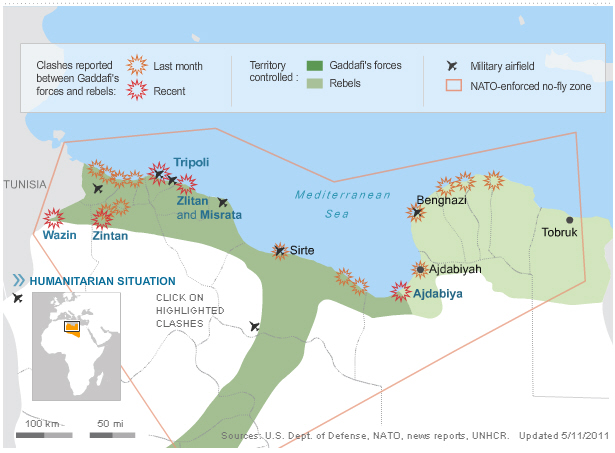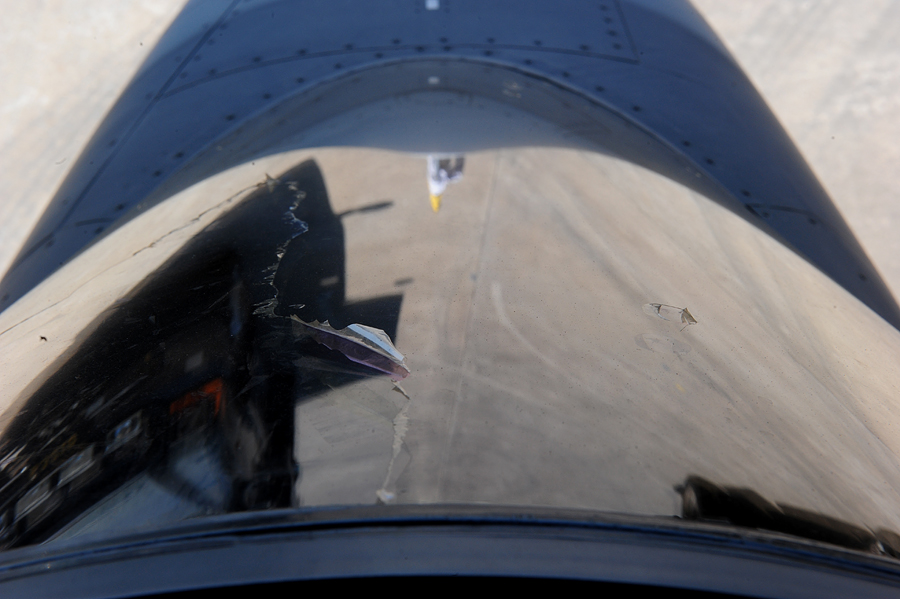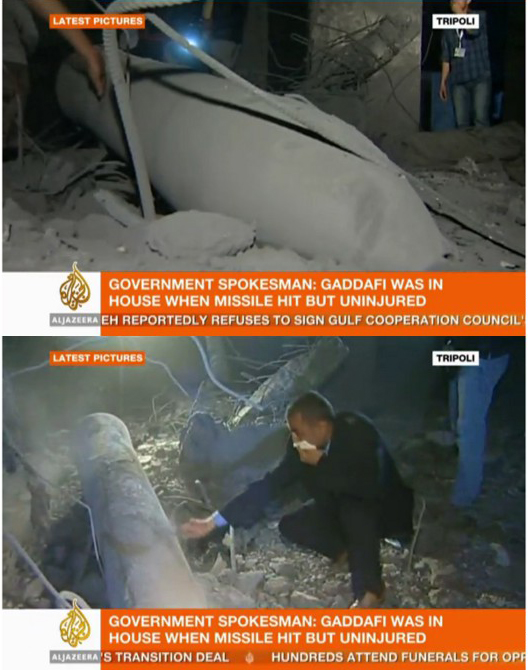Previous debriefings: Archive
Not so many things have happened on the battlefield during the last days, when media were focused on the Osama Bin Laden raid and the famous Stealth Black Hawk. For sure, the most significant event occurred on May 11, when rebels claimed to have captured the airport in the besieged western city of Misratah, Libya’s third-largest town. The city has been surrounded for weeks from Gaddafi’s forces and split roughly along an east-west road with loyalist controlling the areas south of the road, including the airport, located around 5 Km from the city centre and Tripoli Street, the avenue that has been the scene of heavy street fighting. According to some sources, rebels have not yet taken full control of the military part of the airbase, because pockets of residual fighting were reported in the area.
Credit: Reuters
The achievement is extremely important as it gives the rebels a new outpost from where a new advance towards Tripoli, that is only some 200 km away, can start. For this reason, Gaddafi’s forces have shelled the town with rockets and heavy artillery fire for weeks. Loyalists repeatedly tried to mine the port using small vessels and, on May 6, they used helicopters bearing the Red Cross emblem to drop mines in the harbour (even if this was not confirmed by NATO, read below) while, on the following day, aircraft reported to be a “crop dusters” (small aircraft used for spraying pesticides) dropped bombs on oil storage tanks in Qasr Ahmed neighborhood, in the easter part of the town. Even if it is not clear whether the aircraft involved were actually surviving LARAF (Libyan Arab Republic Air Force) SF-260s from Misratah airport or other type of aircraft, noteworthy, these violations of the No-Fly Zone raise questions about the effectiveness of the NATO combat air patrols in one of the most important towns in Libya. In fact, even if small planes and helos, flying at extremely low level in the ground clutter can be difficult to detect even for an E-3 AWACS orbiting nearby, if fighters are CAPping not far from the airport they will still be able to detect visually detect such “slow movers” visually, at least during daylight. At night it is probably more difficult but, since many interceptors involved in DCA (Defensive Counter Air) role fly with Litening targeting pods as explained many times in previous Debriefs, I assume they use the pod also to look for possible aerial targets of opportunity in the vicinity of airports and urban areas even small planes should be clearly visible by means of the high-resolution, FLIR (Forward-Looking Infrared) sensor of the pod.
Furthermore, on May 5, NATO destroyed two or three helicopters carried by big trucks heading towards Tiji, a small town near Libya’s border with Tunisia. It is not clear if the helos were being moved to be hidden from NATO warplanes or were being relocated for use against rebels in the area of Zintan, however this activity suggests that Gaddafi has some surviving aircraft and he’s willing to use them. Therefore, there are some concerns that he could use them to drop dirty bombs.
How’s NATO performing?
This question is open to debate. In the last days criticism was caused by reports of migrants from Libya dying at sea: Gaddafi is forcing people out of the country by boat using them as a sort of retaliatory attack against European nations supporting Unified Protector, that are now facing a humanitarian crisis. NATO was blamed for not doing enough to prevent several boats filled with migrants from sinking causing hundred deads.
The answer came from NATO Deputy Spokesperson, Carmen Romero on May 10 Press Briefing:
We have also been asked what action NATO is taking to protect such migrant ships at sea. Let me be clear: NATO’s mission is to prevent attacks on civilians and civilian populated areas in Libya. That is what the United Nations Security Council mandated.
But while they are carrying out that mandate, ships under NATO command will always respond to calls from ships in distress. This is their duty under the law of the sea, and to suggest that our ships’ captains would do otherwise is unfair and disrespectful.
For example, on the 26th of March NATO ships responded to information that two migrant ships, with over 500 people on board were in difficulty, who were then provided direct assistance by the Italian authorities. That included a NATO ship using its helicopter to airlift two women and a newborn child to medical help.
Dealing with the air campain, ItAF Brigadier General Claudio Gabellini (Chief Operations Officer, Operation Unified Protector) explained that, in the last week alone, NATO has engaged multiple rocket-launcher systems, command-and-control facilities, anti-aircraft weapons, military bunkers and ammo facilities, tanks and armoured fighting vehicles, undelining once again that the coalition is diminishing Gaddafi’s capacity to issue orders, to field troops and to fly his planes.
For what concerns Misratah port he said:
At sea we have cleared sea mines laid by pro-Gaddafi forces in the approaches to the port of Misrata on April the 29th. Two of the mines were destroyed by NATO mine countermeasures vessels and the third, which has not been found, is no longer considered a serious threat.
We’ve also swept the approaches of Misrata harbour and consider that there is no immediate mine threat for the timing being. Our maritime forces are prepared to respond to any similar threat.
We fully recognize how important the port is to the citizens of Misrata. While the decision to open and close the port rests clearly with Misrata port control, we note that since NATO vessels destroyed the mines and cleared the areas more than 15 vessels have entered the port.
Answering to a question about the use of military helicopters with Red Cross insigna, he explained that:
we have lots of reports talking about helicopters wearing the red cross on them, but we have no, absolutely we have no evidence at all. What I can say it’s been five days since we last had the last report talking about helicopters overflying Libya
Many questions of the Q&A part of the Press Briefing focused on the possibility that NATO is targeting individuals (Gaddafi in particular, who appeared again in TV for the first time in two weeks on May 11 denying rumours/speculations according to which he was killed by an allied raid). Here’s how Brig. Gen. Gabellini answered:
All NATO targets are military targets. Which means that the targets we’ve been hitting, and it happened also last night in Tripoli, are command-and-control bunkers. And again, just to make clear the stuff that NATO is not targeting individuals. It’s not in our mandate. Our mandate is to protect civilian population from attacks or from the threat of attacks by Qadhafi regime forces
[…]
We have no evidence about what Mr. Gaddafi’s doing right now. And I tell you the truth, we’re not really interested in what he is doing. Our mandate is to protect civilians from the attacks and from the threat of attacks so we’re not looking after individuals.
[…]
No individuals are a target for NATO. We only look after command-and-control centre because we want the targets we’re after is to stop Mr. Gaddafi to give orders to his troops to keep slaughtering the civilians and to prevent humanitarian aid to enter the country.
Let’s have a look at Unified Protector’s figures. Since the beginning of the NATO operation (31 March 2011, 08.00GMT) a total of 6232 sorties, including 2460 strike sorties have been conducted.
During the last 24 hours, 141 sorties were flown comprising 46 strike sorties. The key targets were: 4 Ammunition Storages, 4 Command & Control Facilities, 2 SAM Launchers, in the vicinity of Tripoli; 4 SAM Launchers, in the vicinity of Surman; 1 SAM Launcher, in the vicinity of Misratah. I would be curious to know which SAM sites NATO is still targeting (are there remaining mobile launchers?) and which ammunition depots, since there are so many in Libya (according to various sources around 3 and 4.000) that it will take months, if not year, to hit them all….
Here’s the usual sorties breakdown
| Date | Total sorties | Air strikes | air strikes/total |
| 22-mar | 175 | ||
| 24-mar | 130 | 49 | 38% |
| 25-mar | 153 | 91 | 60% |
| 26-mar | 167 | 88 | 53% |
| 27-mar | 178 | 107 | 61% |
| 1-apr | 178 | 74 | 42% |
| 2-apr | 174 | 74 | 43% |
| 3-apr | 184 | 70 | 39% |
| 4-apr | 154 | 58 | 38% |
| 5-apr | 150 | 58 | 39% |
| 6-apr | 155 | 66 | 43% |
| 7-apr | 164 | 73 | 45% |
| 8-apr | 155 | 54 | 35% |
| 9-apr | 156 | 60 | 39% |
| 10-apr | 133 | 56 | 43% |
| 11-apr | 154 | 70 | 46% |
| 12-apr | 158 | 59 | 38% |
| 13-apr | 159 | 60 | 38% |
| 14-apr | 153 | 58 | 38% |
| 15-apr | 146 | 60 | 42% |
| 16-apr | 145 | 58 | 40% |
| 17-apr | 144 | 42 | 30% |
| 18-apr | 145 | 60 | 42% |
| 19-apr | 143 | 53 | 38% |
| 20-apr | 139 | 62 | 45% |
| 21-apr | 132 | 50 | 38% |
| 22-apr | 152 | 62 | 41% |
| 23-apr | 138 | 59 | 43% |
| 24-apr | 144 | 56 | 39% |
| 25-apr | 143 | 62 | 44% |
| 26-apr | 133 | 56 | 43% |
| 27-apr | 123 | 52 | 43% |
| 28-apr | 119 | 41 | 35% |
| 29-apr | 142 | 67 | 48% |
| 30-apr | 165 | 43 | 27% |
| 1-mag | 165 | 60 | 37% |
| 2-mag | 158 | 56 | 36% |
| 3-mag | 161 | 62 | 39% |
| 4-mag | 160 | 49 | 31% |
| 5-mag | 154 | 57 | 38% |
| 6-mag | 149 | 56 | 38% |
| 7-mag | 153 | 58 | 38% |
| 8-mag | 159 | 64 | 41% |
| 9-mag | 146 | 46 | 32% |
| 10-mag | 123 | 42 | 35% |
| 11-mag | 141 | 46 | 33% |
Graphs below, clearly show that the number of air strikes is still slightly decreasing.
Other interesting things, information and thoughts:
1) Some updates from the involved air forces. The last news release by the Italian MoD reports 53 missions flown by the Italian contingent (should be 106 sorties at least). No further words on weapons, targets etc. Aircraft involved in the air strikes are Tornado IDSs and ECRs of the ItAF and AV-8Bs of the Italian Navy from Garibaldi aircraft carrier. Pictures and videos published on the ItAF website show the Tornado IDSs loaded with 3 GBU-32s or 1 or 2 LGBs (GBU-24 or 12). Noteworthy, the enforcement of the NFZ is not only performed with F-2000 Typhoons but once again also by F-16ADFs of the 18° Gruppo.12 aircraft and 4 ships were trasferred under NATO command by Italy.
Dealing with the RDAF, the latest update reports 176 missions flown since Odyssey Dawn began and 376 PGMs dropped.
The Canadian contingent at 23.59 hr UTC on May 11 had flown 248 sorties with the CF-188s; 95 with the CC-150 POLARIS and 39 with the CP-140 AURORA.
RNoAF on May 7, had flown 275 missions with 247 dropped bombs, however its F-16s could return home by the end of June according to Government sources. It is still not clear though whether the aircraft will continue contributing to Unified Protector or will be reduced in numbers or simply replaced by other assets (thanks to Aksel Magdahl for keeping me updated with Norwegian news).
2) Karl-Johan Norén sent me some interesting news about the Swedish Air Force Libyan ops. First of all, on the SweAF website an interesting picture of a crakled canopy of a Gripen was published (see below). Two aircraft were returning from a mission over Libya when the front window of the aircraft was damaged. Even thought investigation is in progress sandstorm or electric discharge may have caused it.
Furthermore, a report from Swedish channel TV4 was aired on May 5. It’s an interview given by flygvapeninspektör (Air Force Inspector, in effect commander of the Swedish AF) Anders Silwer covering the following topics (Karl-Johan provided the following abstract):
- The Swedish mission is going well. Most common mission is tactical reconnaissance to within 100-200 kilometers from the Libyan coast. He estimates the Swedish AF covers about 1/3 to 1/2 of the tactical
reconnaissance resources within Unified Protector. - They do four “flygplansföretag” (sorties) daily, and plans to increase it to six.
- They photograph AA positions, command centrals, etc. They have not been attacked, as far as they can tell. They have been locked by radar a few times. No Swedish aircraft has fired a shot in anger.
- Mentions that they could do more tactically for the situation on the ground, but says that this is a political question, not a military one.
3) One of the most interesting thing of the last weeks is that UAE AF has joined the bombing campaign in Libya along with the other partners involved in the air strikes (US with drones and SEAD assets, Denmark, Norway, Belgium, Italy, UK, France and Canada) even if the news has not been made public yet. The following pictures were taken on May 1, 2011, at 14.06Z by Antonio Di Franco, from his home, located a few kilometres to the south east of Sigonella airbase. The images show two UAE Air Force Mirage 2000s carrying a Damocles targeting pod and an MBDA PGM-500 500lbs guided bomb (“Hakim”) along with two MICA air-to-air missiles.
Below, two more pictures taken on May 7 once again by Antonio Di Franco.
4) On Apr. 30, an attack performed in a bunker in Tripoli killed Gaddafi’s youngest son, Saif al-Arab Gaddafi, with three minor grandchildren. Even if the Guardian immediately suggested that the raid was conducted by the Royal Danish Air Force, there were no proofs (and maybe there are still none) that Denmark was involved in the raid. However, basing on images of an unexploded warhead in the ruins of Gadhafi’s house, it was possible to try to determine which country performed the strike. In fact the bomb shown in the Guardian and also on Al Jazeera English footage is a part of the JDAM: in particular, it is a BLU-109 penetrator warhead. Warhead + GPS guidance kit is known as GBU-31(V)3/B in USAF (RDAF call the bomb using BLU-109 GBU-31B while the one with Mk-84 warhead is known as GBU-31A). Many air forces use the GBU-31 with BLU-109 however, Andreas Lindqvist, a journalist of the Politiken newspaper, with my advices, investigated the facts, contacted the various countries involved in the air strike and one by one virtually eliminated all the other seven countries that drop bombs on Libya coming to the conclusion that, as suggested by the Guardian, the compound was probably hit by a Danish strike.
Images credit: Reuters / AJE
Eight countries were involved in air strikes within Unified Protector at the time of the raid: Denmark, Norway, Italy, Belgium, France, Canada, UK and the US. UAE could be added to the list but there’s no official confirmation and aircraft don’t carry that type of bomb.
- Denmark: did not want to comment.
- Norway: No. They deny that they were involved in the specific raid. Interestingly, RNoAF used BLU-109/GBU-31 on Apr. 25 attack on the Gaddafi compound.
- Italy: Unknown, but most probably not involved since Tornado are flying with GBU-32s and LGBs. Not sure GBU-31 with BLU-109 were ever tested on Tornados.
- Belgium: No. They didn’t fly that day.
- France: No. They deny using that type of bombs in Libya
- Canada: No. They use none of the technologies.
- UK: No. They have the Paveway, but not the GBU-31.
- US: Unknown, but probably no. They have the technology and experience but they were officially not flying as they only fly support missions. They also fly the presdator drones, but the current generation cannot carry that bombs.
Basing on the above elements, Andreas asked me how likely I think it was Denmark to perform the strike. As he mentioned in the article published on May 12 on the Politiken website, basing on basing on the information available, on the replies he received and above all considering that RDAF is doing a great job in Libya flying lots of missions and
dropping many bombs; that it didn’t deny it but just didn’t comment it and finally, that diplomatic sources reported by the Guardian suggested the strike was one of the many performed by RDAF, I think it is extremely likely. Obviously denying or not something doesn’t prove or not an involvement. But I agree with Andreas Linqvist when he says that such organisations do not lie directly. “Its too dangerous in the long run”.


















